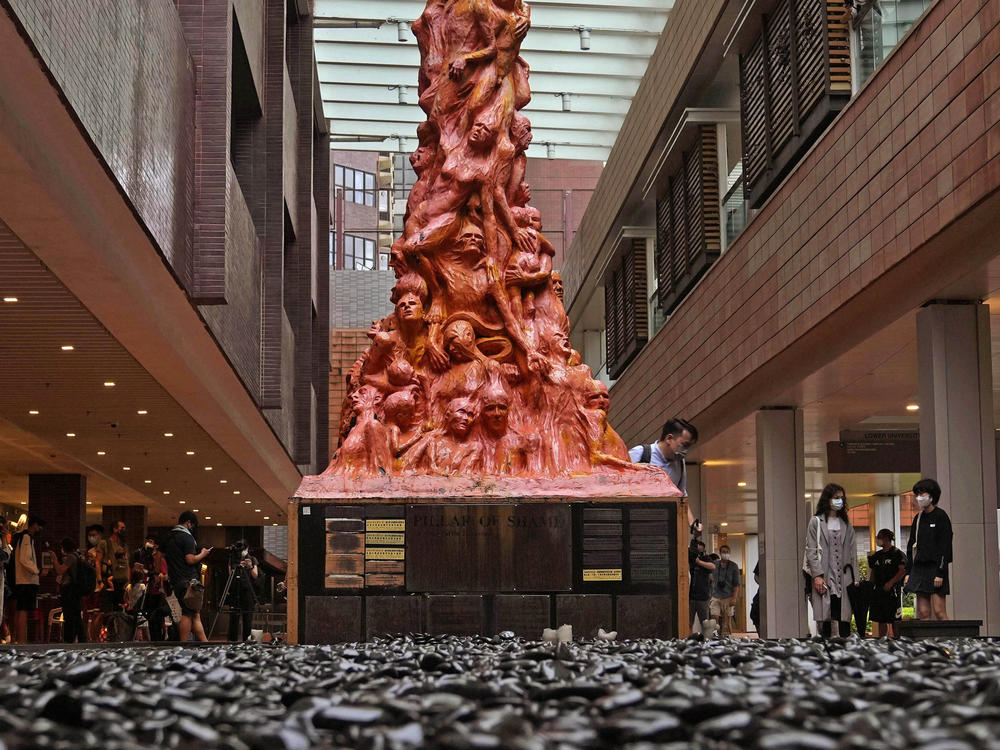Section Branding
Header Content
A Hong Kong university orders the removal of a memorial to the Tiananmen massacre
Primary Content
A 26-foot-high sculpture commemorating the victims of the 1989 Tiananmen Square massacre is set to be removed from the campus of the University of Hong Kong in what activists see as the latest sign of Beijing's suppression of freedom in the territory.
The university set a deadline of Wednesday for the Hong Kong Alliance in Support of Patriotic Democratic Movements of China — an activist group that was forced to disband last month — to take the memorial down. Representatives of the now-defunct group have asked for more time, due to a typhoon that has battered the territory in recent days, but it's not clear if the extension would be granted. As of Wednesday evening local time, the memorial appears to remain at the university.
In a letter, the university insisted that if the sculpture wasn't removed by 5 p.m. on Oct. 13, "it will be deemed abandoned."
Speaking this year at a June 4 ceremony in which students wash the sculpture, a student activist told reporters, "We hope to defend historical truth given that our freedom of speech is dwindling."
The structure, known as the Pillar of Shame, is the work of Danish artist Jens Galschiot. Unveiled in 1997, it depicts some 50 anguished and intertwined bodies that rise from the ground in a narrow pyramid. It is reportedly the only major memorial to the massacre still standing on Chinese soil. On June 4, 1989, soldiers of the People's Liberation Army brutally cleared pro-democracy protesters from Beijing's Tiananmen Square. Estimates of the number killed range from hundreds to thousands.
Galschiot, the artist, has called the sculpture's removal an "attack on art." He says the work was technically on indefinite loan from him. He says he is discussing with Danish politicians the possibility of bringing it back to his home country. He has also said that it may wind up elsewhere in Europe, Taiwan or the United States.
"It will take a long time to move the sculpture," he said in a statement on Saturday. "It is an extremely valuable piece of art, which after 24 years probably is a bit frail. Therefore there is a great possibility that the work of art will suffer irreparable damage if handled by any others than experts in handling art." He warned the university that it "risks incurring a claim of compensation" if the artwork is damaged.
In its legal quest to have the artwork removed, the university enlisted the Mayer Brown law firm. The firm told Hong Kong Free Press that it was being retained "as outside counsel [to] help our clients understand and comply with current law."
"We were asked to provide a specific service on a real estate matter for our long-term client, the University of Hong Kong," the firm said. "Our legal advice is not intended as commentary on current or historical events."
The order to take down the sculpture follows a series of moves by Beijing to take firmer control of Hong Kong, a former British colony that was handed back to China in 1997 under an agreement meant to ensure that the territory would enjoy a degree of autonomy and that basic freedoms would be guaranteed.
Last year, a series of massive protests in Hong Kong erupted over a proposed law to extradite the territory's residents to mainland China for certain high-level criminal cases. The law went into effect anyway. Beijing has also used the tough new national security law to shut down dissent in the territory and sought to purge pro-democracy lawmakers from Hong Kong's legislature.
A museum documenting the Tiananmen Square massacre also has been shut down and an annual vigil in Hong Kong to remember the June 4 victims has been banned and its organizers arrested.
Copyright 2021 NPR. To see more, visit https://www.npr.org.

